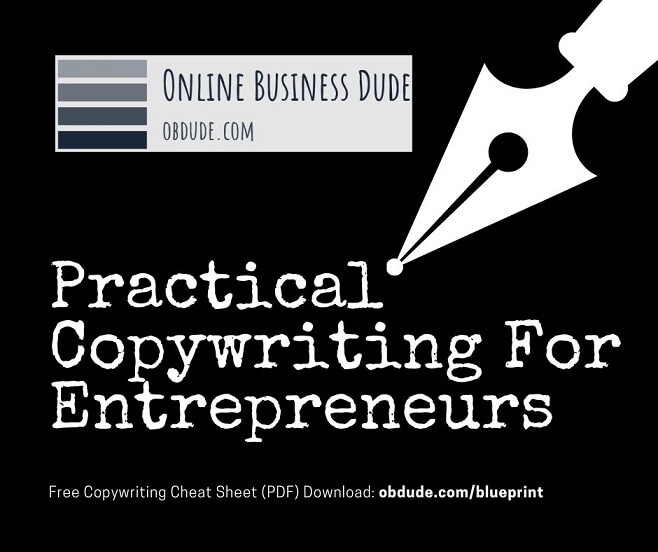Practical Copywriting For Entrepreneurs
This is a simple but extremely powerful and highly practical copywriting framework.
It’s highly practical so you can implement it rapidly and immediately in your online or affiliate marketing business.

Why Is This Important?
Writing effective copy (that gets opened/clicked, read and - most importantly - acted upon) is one of the most valuable skills to learn in today’s marketplace.
Think of it as salesmanship in print.
If you can write great copy and persuade people into taking action, you will never be hungry again… It’s _that _powerful.
What Is The PAISA Copywriting Framework
I read through and worked myself through lots of books, different texts, and frameworks on copywriting.
PAISA is undoubtedly one of the basic but also most powerful frameworks I came across so far.
It’s like a “natural but direct progression” from the prospect’s problem to (your) solution.
And it’s a solid foundation, a formula, a very solid base to begin with when working with sales letters, copywriting of any type, advertising, working with media etc.
This formula applies also to one on one or one to many selling, of course.
You can find it in some form or variation in almost any sales letter or copywriting piece.
The Source Of PAISA
Before diving in, I want to give credit where credit is due.
I heard it first from Dan Kennedy.
Here’s a short video in which he explains the concept:
What Does PAISA Stand For?
- Problem
- Agitate
- Invalidate
- Solution
- Action
PAISA, One By One
Problem
Establish a problem that the intended buyer (ideally) knows already about / is already aware of, disturbed about, and interested in solving.
But it also can be a problem you “plant” in the minds of your prospect if you must.
Something you make him aware of he didn’t actually know was a problem.
This is kind of an educational sale.
Agitation
Another way to think of this is “emotionalizing the problem”.
People rationalize/justify purchases by facts, numbers, logic, statistics and rational arguments.
Almost all decisions are actually made based on emotion. (pain/gain/…)
How to agitate the problem then?
Connect the problem to important, emotional (pain) points of your prospect.
Like how their kids would be influenced by it (better future), how an important person (family) in their life would benefit from it, animals in the house, etc.
But also how any other important, emotional shortcomings and pain points would be affected by the problem over time.
You create emotional angst and anxiety connected to the problem.
Invalidation
In this step, we invalidate all other (available) solutions except yours.
Why XYZ hasn’t worked for them so far etc.
This is also where our USP (unique selling proposition) comes into play.
Because in the next step we present our…
Solution
This is your product or service that solves your prospect’s problem.
The USP is important because we need to point out why and how we solve the prospect’s problem in the (for example) best, fastest, most enjoyable, most convenient, cheapest or most efficient way, once and for all.
At this step, we also want to “turn around” the emotional pain from the agitation step and “future pace” by painting a brighter future (with the help of our solution).
At this point our prospect understands he has a problem, he can feel it, understood no other solution would help, and we presented our solution and connected it to a better future in which the problem is completely solved.
Action
The last step is the call to action.
It’s simply asking for the order.
Often, we want our prospects to act immediately - but don’t let this sales-related thought stand in the way of effective follow-up sequences and techniques.
We want to make our best effort to make a sale at the point when we complete the presentation.
We do this by implementing
- impending urgency (for example via discounts, the price goes up tomorrow, or via upcoming events, etc.)
- scarcity (there’s only X number available, we can only work with X clients, …)
- powerful guarantees(risk reversal, we want to take away the risk of a potentially wrong, hasty decision)
- overwhelming, preponderance of proof (to - again - overcome the emotional pain of “potentially making the wrong purchase decision, like so often in the past…”)
Long Copy Vs. Short Copy
I don’t want to present all arguments for or against how long copy should be here (this discussion probably goes back to cavemen arguing about it), but instead I let Gary Halbert take over:
The people who are non-prospects aren’t gonna read three paragraphs of your ad. The people who are geniune prospects for your product want to know every damn single detail about it as long as it is still relevant. Don’t worry about long copy as long as it is still relevant.
- Gary C. Halbert
Since we only care about the poeple (in business) who potentially buy what we have to sell, we want to make our copy as long and detailed as possible, as long as it is still relevant.
But make sure to “help them, get through it”.
Give them several, different options to buy.
Make the whole experience as hassle-free as possible.
Closing Thoughts
I hope you find this article helpful.
Thank you for reading and stay awesome,
Tim for Online Business Dude
PS: Start And Grow Your Own, Profitable Online Business!
